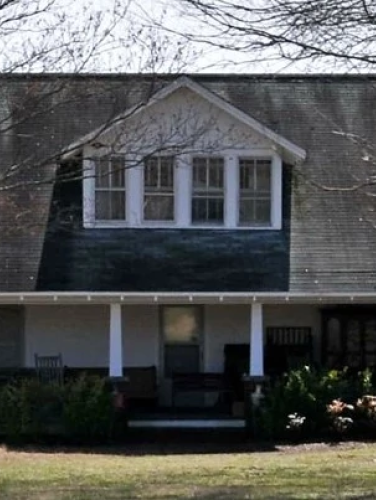
Jesse & Mary K. Washam Farm
(ca. 1900)
The Washam Farm was anchored by a rare example of a bungalow-style farmhouse originally constructed as a three-room tenant house.
15715 and 15619 Davidson-Concord Rd, Davidson, NC 28036
The Jesse and Mary K. Washam Farm offers a tangible reminder of the last prosperous years of Mecklenburg County’s once thriving agrarian economy. By the late 1920s and early 1930s, national and regional economic depressions ended both the era of southern dominance over cotton production and the autonomy of small independent cotton farmers. Originally a three-room tenant house, the Washam farmhouse is a rare surviving example of a bungalow farmhouse in Mecklenburg County, representing a break from the area’s typical frame I-house farmhouses. As Jessie Wilson Washam (1885-1939) expanded his agricultural operations, the farmstead grew with it. Several outbuildings were added over the years, including a large barn, tool shed, corn crib, chicken and brooders houses, a cotton shed, a tenant house, and a concrete-block well house.
Property Quick Links
Jesse’s father Henry Jackson Washam (1827-1901) began farming a thirty-acre plot of land in the Ramah community along the Davidson-Concord Road, which he most likely acquired through his marriage to his first wife, Mary E. Shields (1833-1877), in the mid-nineteenth century. He and his family lived in a simple, frame I-house (no longer extant), raising cotton and corn as primary cash crops. As Henry’s farming operations proved successful, he acquired additional plots of land on the north and south sides of Davidson-Concord Road totaling nearly 200 acres by 1901. Jesse, who had left the family home in Ramah and moved to Cornelius to live with his uncle, inherited just under 32 acres and one of the farm’s three tenant houses. After his marriage to Mary K. Knox in 1909, Jesse returned to Ramah, moved into the modest three-room tenant house, and began farming. By 1913, he had acquired approximately 110 acres of his father’s original farmstead. The family grew corn, grain, and cotton as major cash crops.
Throughout the 1910s and 1920s, Jesse made several changes and additions to his farmstead. By 1922, he was successful enough to undertake a major renovation on the house itself, constructing an addition that roughly tripled the size of the house and completely changed its appearance. By the mid-1920s, the original three-room house was completely obscured behind the new stylish front of a spacious, one-and-a-half story bungalow cottage. The expansion was the product of Jesse’s last prosperous years as a cotton farmer. By the beginning of the Great Depression, cotton prices had already slipped considerably, and farmers throughout Mecklenburg County were forced to reduce their crop and livestock production or sell their farms. Although he managed to weather the hard times and keep his farmstead, Jesse’s farming operations were never as profitable as they had been in the first decades of the twentieth century. Following Jesse’s death in 1939, the property remained in the Washam family, but portions were sold off over the years. By the 1990s, only the Washam house, a few of the outbuildings, and nearly 1.5 acres remained Washam family property.

